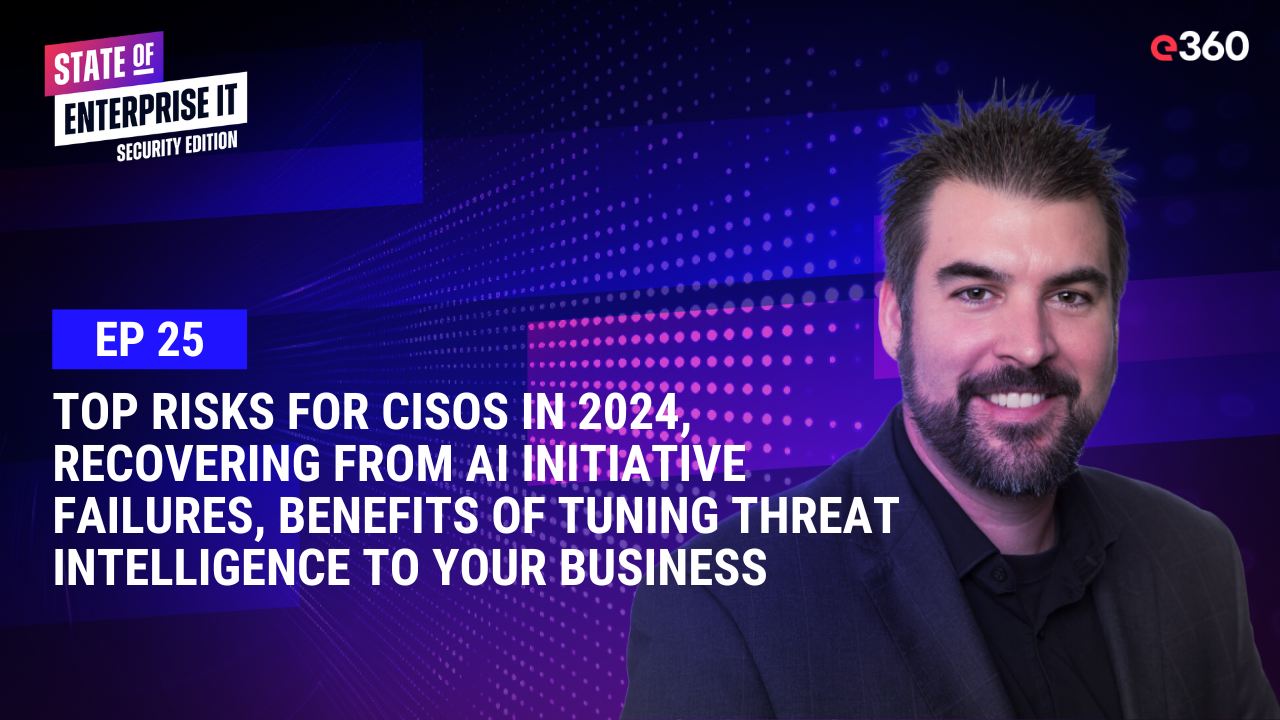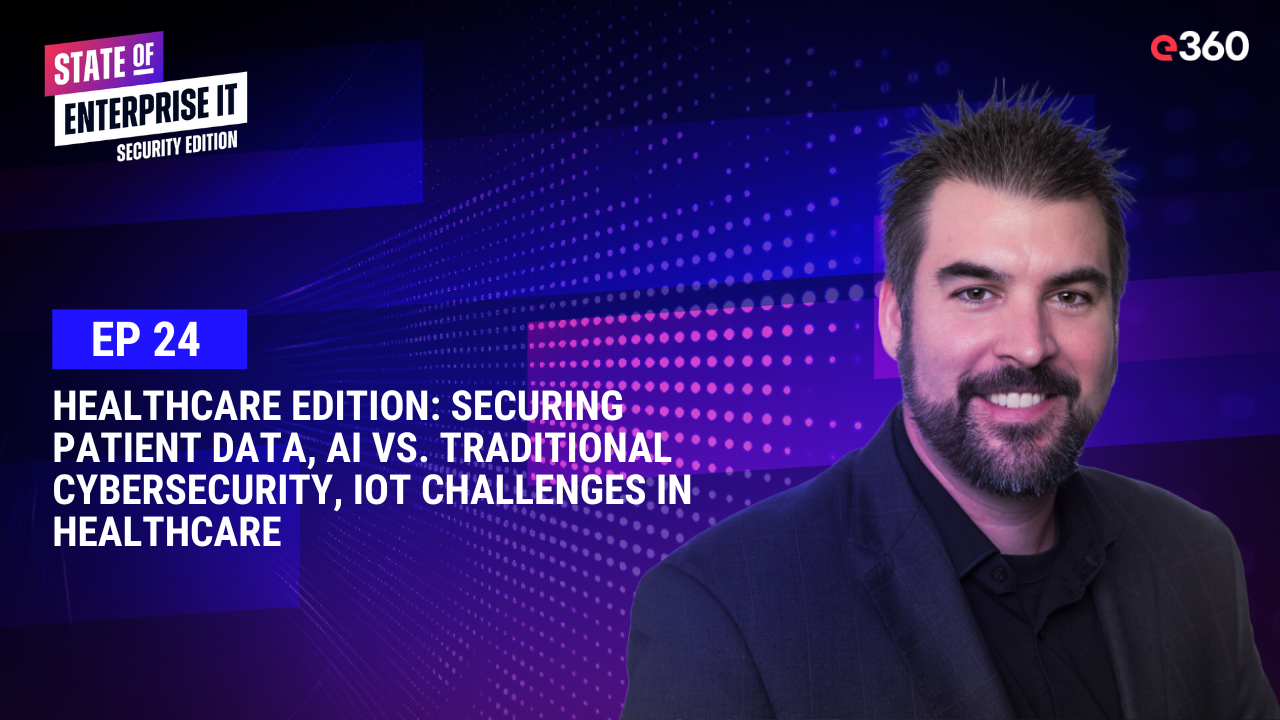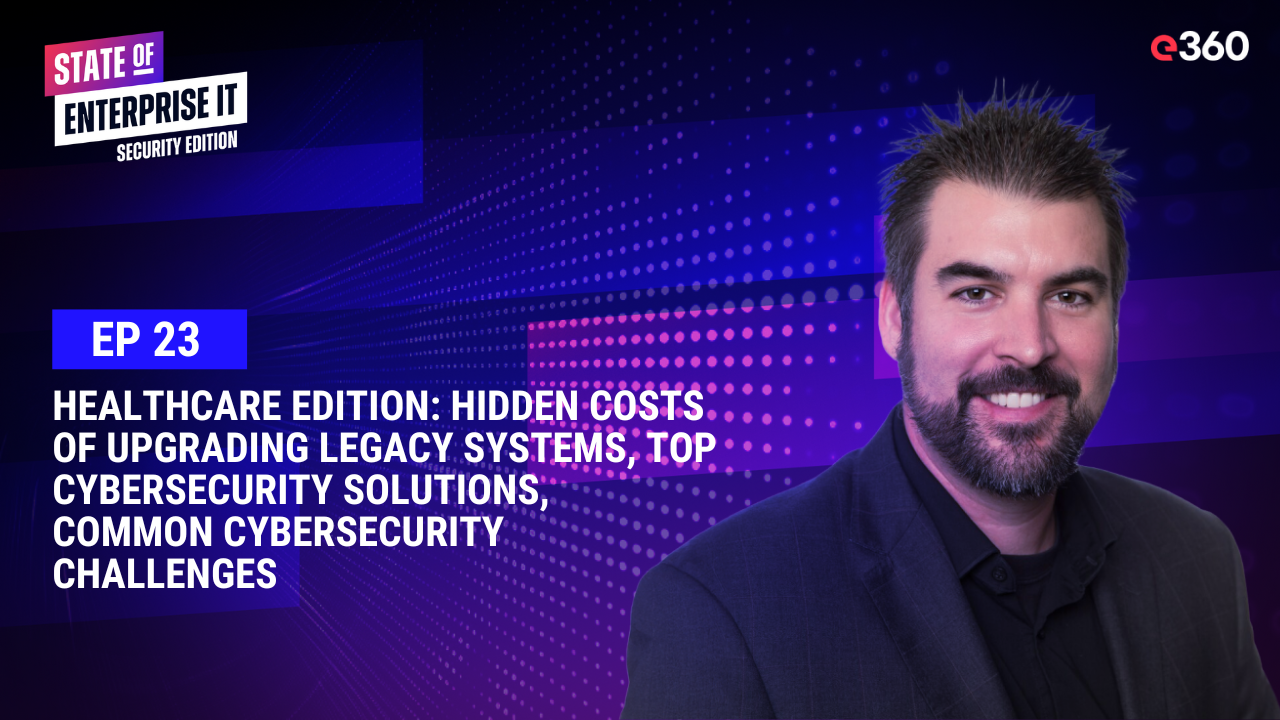Overview:
In Episode 25 of The State of Enterprise IT Security, Brad Bussie examines the critical challenges faced by Chief Information Security Officers (CISOs). He also discusses why many AI initiatives struggle to succeed and explains the benefits of customizing threat intelligence for different business verticals. Tune in for valuable insights and actionable strategies to strengthen your cybersecurity approach.
Listen to the Episode:
Watch the Episode:
[00:00:00] Brad Bussie: High accountability and stress. Being a CISO means shouldering immense responsibility. When a security breach occurs, all eyes turn to the CISO. And despite having robust security measures in place, they often face significant scrutiny and blame if a breach happens.
[00:00:28] Hey, everyone. I'm Brad Bussie, Chief Information Security Officer at e360. Thank you for joining me for the State of Enterprise IT Security Edition. This is the show that makes IT security approachable and actionable for technology leaders. I'm happy to bring you three topics this week. First, what are some of the risks involved with being Chief Information Security Officer?
[00:01:14] Brad Bussie: Second, our AI initiative failed, but why and what should we do next? And third, what are the benefits of tuning threat intelligence to your business vertical? And with that, let's get started.
Risks of Being a CISO
[00:01:30] Brad Bussie: So what are some of the risks involved with being a Chief Information Security Officer? I wanted to dive into this topic that I think is crucial for understanding the high stakes role of a chief information security officer. Some call it CISO, others CISO, but either way, it's the same thing. So if you've ever wondered what it takes to be at the helm of an [00:02:00] organization's cybersecurity efforts or the risks involved, this episode's for you.
[00:02:07] Brad Bussie: And honestly, I want you to walk away from this conversation knowing a little bit more about why cybersecurity professionals behave the way that they do.
[00:02:17] Brad Bussie: High accountability and stress. Being a CISO means shouldering immense responsibility. When a security breach occurs, all eyes turn to the CISO. And despite having robust security measures in place, they often face significant scrutiny and blame if a breach happens.
[00:02:46] Brad Bussie: And this high level of accountability can lead to substantial stress. Imagine being on high alert, 24 seven, constantly thinking about potential threats and vulnerabilities. It's no surprise that CISOs often report high levels of stress as well as burnout. Then it's legal and regulatory risks. So when you look at legal and regulatory risks, a CISO must ensure their organizations comply with a ton of laws and regulations such as GDPR, HIPAA, and PCI DSS.
[00:03:33] Brad Bussie: And failure to comply can result in hefty fines and legal penalties, not to mention the damage to the organization's reputation. And in some cases, CISOs can even be held personally liable for these failures, which adds another layer of pressure. Next, [00:04:00] reputation and career risks. So, a major security breach can severely damage a CISO's professional reputation.
[00:04:09] Brad Bussie: making it difficult to secure future employment in similar roles. The average tenure of a CISO is actually relatively short, often due to the high stakes nature of the job and the rapid evolution of cybersecurity threats. This constant change and the need for up to date knowledge has Really makes the job stability a significant concern.
[00:04:40] Brad Bussie: Uh, the evolving threat landscape. I mean, the cyber security landscape is continually evolving. New threats and vulnerabilities emerge regularly. requiring CISOs to stay ahead of the curve. And this includes dealing with sophisticated attacks from highly skilled adversaries. And this is often known as advanced persistent threat.
[00:05:04] Brad Bussie: And the dynamic nature of these threats makes the role just incredibly challenging and demanding. We are often resource constrained. So resource constraints are a pretty big challenge and often CISOs have to must work with limited budgets, making it difficult to implement necessary security measures.
[00:05:30] Brad Bussie: And additionally, the cybersecurity industry faces a notable talent shortage, finding and retaining skilled professionals to manage and secure the organization's it environment. can be an uphill battle. Then there's internal challenge and they're pretty prevalent. So implementing effective security measures often requires cross departmental [00:06:00] cooperation and resistance or lack of support from other departments can impede a CISO's efforts.
[00:06:09] Brad Bussie: CISOs must balance the need for robust security controls with the organization's operational and business goals. So overly stringent controls can disrupt business processes, while lax controls can increase risks. And then incident response and crisis management, really developing and Maintaining an effective incident response plan is crucial, and during a security incident, the CISO must lead the response efforts, which can be highly stressful and time sensitive, so effective communication with stakeholders, including the Board of Directors, employees, customers, and regulators is critical during and after a security incident.
[00:07:09] Brad Bussie: So poor communication can make the incident's impact that much worse. Now, the role of the CISO has significant challenges and risks, requiring a high level of expertise, resiliency, And strategic thinking. But despite these risks, the CISO is vital in safeguarding an organization's information assets and ensuring a strong security posture.
[00:07:42] Brad Bussie: Now, second topic.
Challenges in AI Initiatives
[00:07:44] Brad Bussie: Our AI initiative failed, but why, and what should we do next? So I wanted to explore why so many AI initiatives in organizations are failing, particularly from a security and data [00:08:00] security perspective. So I think this has to do with a lack of data governance and quality perspective.
[00:08:09] Brad Bussie: So really one of the primary reasons AI initiatives stumble is poor data quality and overall governance. I mean, AI systems rely heavily on high quality data really just to function correctly. And when data is incomplete, inconsistent, or inaccurate, the AI models produce unreliable results. And many organizations lack proper data governance frameworks.
[00:08:40] Brad Bussie: So without clear policies, and procedures for data handling. These AI projects are doomed from the start. Imagine building a house on a shaky foundation. It's bound to collapse. Now, inadequate security measures. Next we have insufficient security controls. AI systems by their nature introduce new vulnerabilities.
[00:09:15] Brad Bussie: And without robust security measures like proper access controls, encryption, and continuous monitoring, these systems become prime targets for cyberattacks. And third party risks really can't be ignored. Many AI projects involve external vendors, or cloud services. And if these third parties do not adhere to stringent security standards, they pose significant risks to an organization's data security.
[00:09:52] Brad Bussie: Complexity of AI models. AI models, [00:10:00] particularly deep learning models are often complex, And opaque. This complexity makes it challenging to identify and mitigate security vulnerabilities. AI systems are susceptible to adversaries where malicious actors manipulate information. input data to deceive the system.
[00:10:25] Brad Bussie: So defending against such sophisticated attacks really requires specialized knowledge, which many organizations might actually lack. Then we come to regulatory and compliance challenges. So compliance with data protection regulations like GDPR and CCPA, it's a significant hurdle. I mean, many organizations struggle to align their AI project with these regulatory requirements, leading to potential legal and financial repercussions.
[00:11:01] Brad Bussie: AI systems often require large data sets, which may contain sensitive personal information. And ensuring data privacy and maintaining user consent can be particularly challenging in these scenarios. Thank you And what I'm seeing is insufficient expertise as well as resources. There's a notable skills gap in most organizations.
[00:11:31] Brad Bussie: And developing and securing AI systems requires a unique set of skills. And many organizations simply don't have the necessary expertise in both AI development and cybersecurity. So this lack of expertise leads to poorly implemented and vulnerable systems. Securing AI projects is Resource [00:12:00] intensive and organizations may not allocate a sufficient budget and resources to address these needs adequately and integration with legacy systems, it, it can introduce significant.
[00:12:21] Brad Bussie: Security vulnerabilities, uh, legacy systems often lack modern security features and may not support advanced AI security requirements. Now ensuring seamless and secure data integration across various systems. It's complex and inconsistent security practices can compromise the overall security posture.
[00:12:48] Brad Bussie: So why do most AI initiatives fail? From a security and data security perspective. It's a combination of poor data governance, inadequate security measures, complex AI models, regulatory challenges, insufficient expertise, and integration issues with legacy systems. So addressing these factors, uh, requires a comprehensive approach that includes robust data governance, advanced security practices, regulatory compliance, skilled personnel, and careful integration planning.
Tuning Threat Intelligence to Your Business
[00:13:31] Brad Bussie: Third topic for this week, the benefits of tuning threat intelligence to your business vertical. I wanted to talk about the benefits of tuning threat intelligence to your particular business vertical, but to really hit home with the topic, I decided to focus on our critical national infrastructure, Or CNI.
[00:13:59] Brad Bussie: You often hear me [00:14:00] talk about healthcare, but I figured I would spread the love a little bit with this episode. Not to mention the fact that compromised CNI could cause a debilitating impact on our security, economy, public health, and safety. So why is CNI a prime and critical national infrastructure sites?
[00:14:29] Brad Bussie: are increasingly targeted by some of the world's most advanced and persistent threat actors. But why? Because these targets include everything from communication networks and transportation systems to energy grids and water utilities. So these sectors are integral to our daily lives and national security, making them high profile targets for motivated adversaries and successful attacks on CNI can demonstrate.
[00:15:09] Brad Bussie: Adversary infiltration, as well as digital superiority creating a significant impact on public trust and national stability. However. These sectors are becoming more vulnerable due to ongoing digital transformation. While digital transformation is essential to meet the service expectations of modern citizens, it introduces a host of new risks and interdependencies between different systems and services.
[00:15:49] Brad Bussie: And this complexity can make it difficult to identify and manage potential vulnerabilities. Now there's some real world [00:16:00] examples of CNI threats. So let's consider two recent stories that highlight these vulnerabilities. So first, I think it was the Wall Street Journal reported concerns about undersea cables, pretty crucial for global internet traffic.
[00:16:18] Brad Bussie: Being vulnerable to espionage from Chinese repair ships. And these cables owned by major digital service providers like Google and Meta rely on third party maintenance specialists, some of whom have foreign ownership, which raises concerns about potential tampering. Another example is the series of attacks on rural US water systems.
[00:16:50] Brad Bussie: And these are attributed to threat actors backed by Russia and Iran. And these incidents illustrate the broad range of CNI sectors at risk and the global nature of the threat. So adding to these concerns. State sponsored Chinese hacker group. I'm not going to say their name. Infiltrated CNI networks across multiple sectors, including communications, energy, transportation, and water systems.
[00:17:27] Brad Bussie: So, this infiltration went undetected for more than five years. shifting from typical intelligence gathering to potentially preparing for major infrastructure attacks. Now, the impact of cyber attacks on CNI can cause widespread disruption with serious consequences for citizens and the economy for instance, an attack on [00:18:00] a power grid or water supply can disrupt essential services.
[00:18:05] Brad Bussie: Endangering lives and eroding public confidence and economically, such interruptions can lead to substantial financial losses as well as supply chain disruptions. Equally important is the impact on national security and the country's reputation. Even if an infiltration is eventually discovered, the fact that it happened and remained undetected for so long can undermine trust in the affected sectors and suggest adversely digital superiority.
[00:18:46] Brad Bussie: Now challenges in protecting CNI. I mean, protecting CNI is, is really challenging for Several reasons. One major issue is legacy technology integration, uh, physical infrastructure, like water, gas, and electricity networks existed long before the digital age. And as technology networks were mapped onto these infrastructures, many now rely on aging industrial control systems as well as supervisory control.
[00:19:27] Brad Bussie: and data acquisition systems efforts to link these with modern cloud based controls and IOT monitoring. They've introduced new vulnerabilities. Uh, for example, addressing a vulnerability and legacy SCADA systems can be difficult without disrupting operations, really leaving a window of opportunity for adversaries to protect CNI effectively.
[00:19:58] Brad Bussie: It's crucial [00:20:00] to understand
[00:20:05] Brad Bussie: your adversary. Different sectors face different threats, and the tactics, techniques, and procedures used by adversaries vary. For instance, the group that I wasn't going to say their name, uh, Really, deviation from typical intelligence gathering methods indicated a potential shift towards planning major attacks and to tune your systems for enhanced protection, I want you to consider some tips.
[00:20:39] Brad Bussie: So establish the context, understand your environment's inherent vulnerabilities, regulatory constraints and available resources. gain situational awareness, integrate vulnerability data from across your entire infrastructure, including cloud on premises, IOT, mobile and legacy systems, consolidate and filter intelligence feeds.
[00:21:12] Brad Bussie: So use the context in data to filter out noise. and prioritize threats with the highest impact and severity. Move from reactive to proactive. So with a stronger understanding of your adversary, start proactively hunting for evidence of their operation. So in conclusion, by tuning threat intelligence systems, CNI providers can better understand and respond to the escalating threat environment.
[00:21:48] Brad Bussie: So this proactive approach can significantly strengthen your security posture against increasingly sophisticated adversary. [00:22:00]
Conclusion and Final Thoughts
[00:22:01] Brad Bussie: So that's all for today's episode of the State of Enterprise IT Security Edition. If you found this discussion valuable, Don't forget to subscribe and share it with your network.
[00:22:13] Brad Bussie: Stay tuned for more insights into critical issues shaping the world of cybersecurity. And until next time, stay safe.



